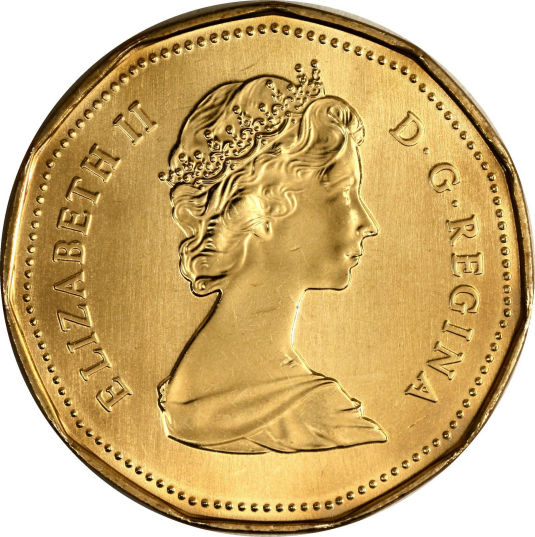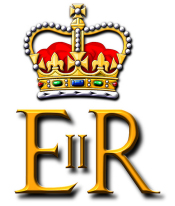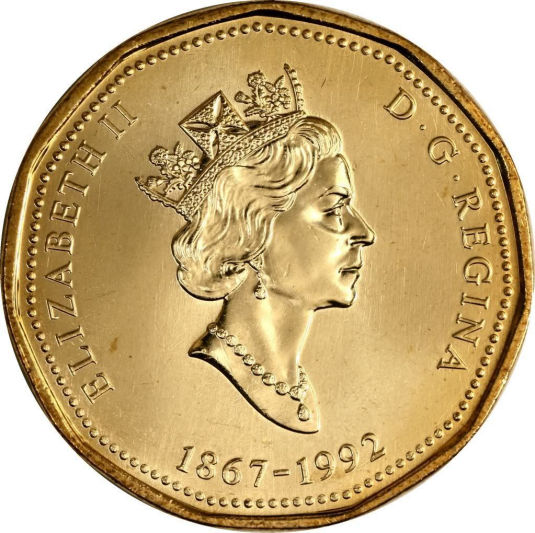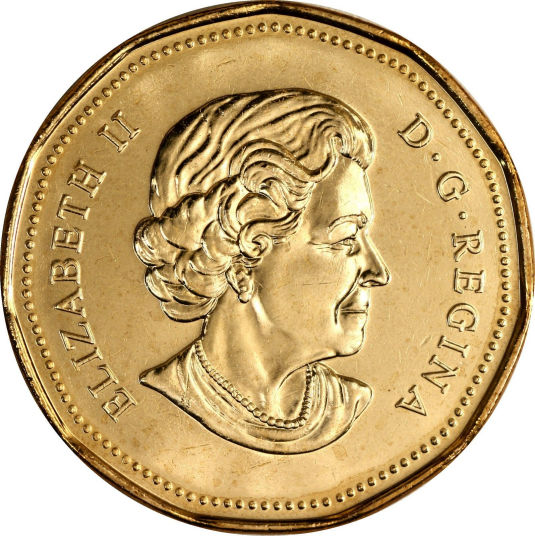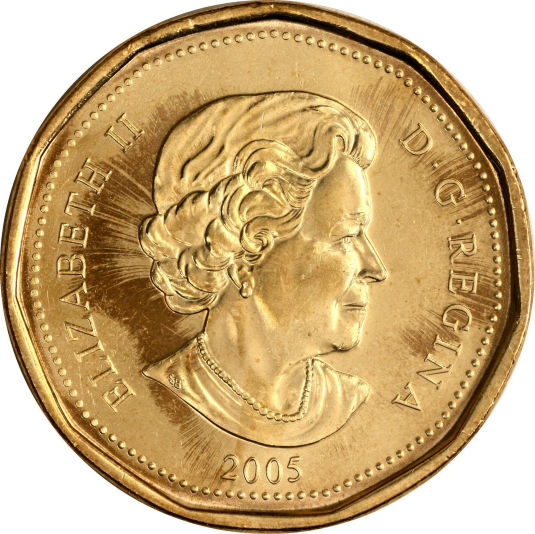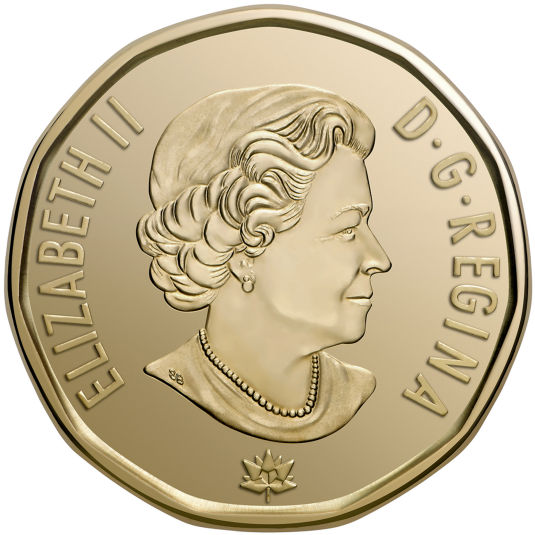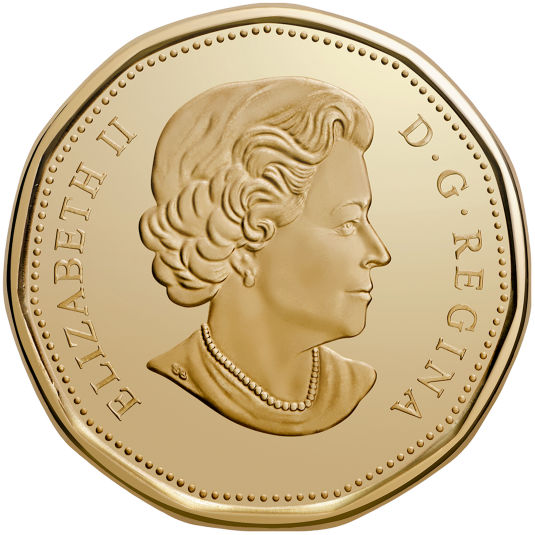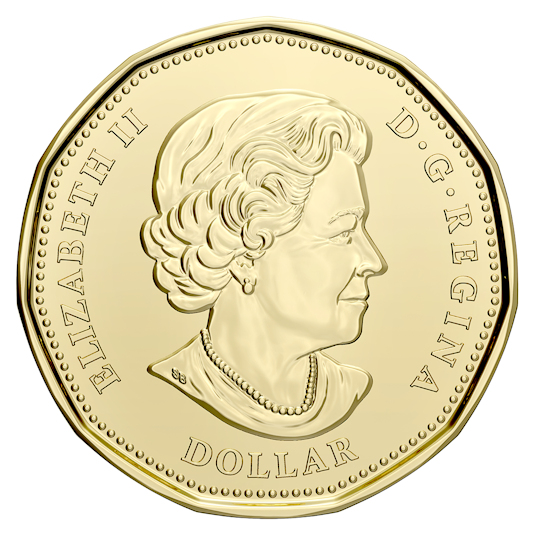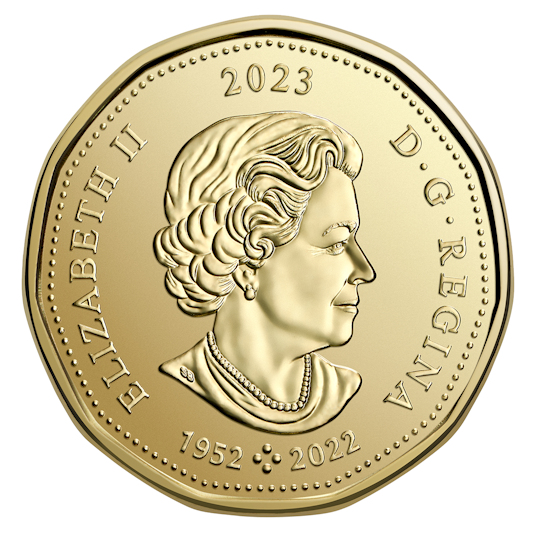Canadian One Dollar Obverse Designs
|
The 1-dollar circulation coin was introduced in 1987 as a cost-saving measure to replace dollar bills. The coin was instantly dubbed the 'loonie' after
the solitary loon that graces the coin's reverse side.
The nickname caught on and Canadians have been using it ever since. The loon design was created by noted wildlife artist Robert-Ralph Carmichael. The illustration has been modified only slightly over the years. This page shows the major obverse die designs since Canadian one dollar coins were introduced in 1987. It does NOT cover "die blunders", where dies were re-punched with different years (and the previous number is visible below the current number), or where cracks appeared in the dies causing unwanted lines to appear in the coin. It also does not cover date doubling. This page only discusses one dollar coins issued for circulation since 1987. It does not include coins which were created exclusively for the collector market (there are a STAGGERING number of them). NOTE: Click on any photo to load a much larger version of the same photo |
||||||||||||||||||
|
||||||||||||||||||
New Effigy (no date) A new obverse designed by Dora de Pedry-Hunt and Ago Aarand was created in 1990 showing the Queen wearing a diamond diadem and jewellery. Note: No Loon coins were issued for circulation between the years 1997-2001. The only coins that exist were issued with uncirculated coin sets |
|
The 125th Anniversary of Confederation A second coin was designed in 1992 utilizing Rita Swanson's reverse design featuring three children with a Canadian flag on Parliament Hill in commemoration of Canada's 125th birthday. The obverse from 1990 was changed to add the dates "1867-1992". |
|
The 1994 National War Memorial and 1995 Peacekeeping coins These special editions use the same obverse designs as the 1990 regular Loon coins, but with the addition of the date below the Queen's effigy. |
|
In 2002 a special dollar was produced celebrationg the 50th anniversary of Queen Elizabeth's coronation. The standard circulation coins for that year
added the dates "1952 2002"
|
|
During the 2003 production run the obverse was changed to feature a new, more mature looking effigy of Queen Elizabeth II,
designed by Susanna Blunt and Susan Taylor. Note: The identical obverse was also used on: - The 2004 "Lucky Loonie" - The 2006 "Lucky Loonie" - The 2010 Navy Anniversary, - The 2010 Sask. Roughriders 100th Anniversary - The 2011 Parks Canada coin. |
|
Lower Date This obverse used the same obverse as the 2003 coin, with the date below the Queen's effigy, was used on the following coins: - The Terry Fox coin commemorating the 25th Anniversary of the Marathon of Hope. - The 2010 Vancouver Olympics "Inukshuk" coin. - The 2012-2016 Loon dollar that incorporated new security features on the reverse side - The 2012 Grey Cup 100th Anniversary coin - The 2012 Lucky Loonie - The 2014 Lucky Loonie - The 2022 Celebrating Oscar Peterson |
|
These use the same design as the 2003 coin, with the addition of a new stylized Royal Canadian Mint logo below the Queen's effigy. The same obverse was used on the 2008 Lucky Loon and the 2009 Montreal Canadiens 100th Anniversary coin. |
|
Women's Suffrage In 1916, Alberta, Manitoba and Saskatchewan granted women the right to vote in provincial elections. Universal suffrage came later, but the history-changing shift in the provinces paved the way for a larger societal shift. This coin uses the 2003 "Mature Queen" effigy with the words "CANADA" above the effigy and "DOLLAR" below the effigy. |
|
While the standard Loon design was used for the classic 1 dollar coin (only produced for the "Classic Canadian Coin Set"), a special series of circulation coins
were produced to commemorate the 150th anniversary of Confederation. For these special circulation coins, the standard RCM logo on the obverse was replaced by the official Canada150 logo. Also, the typeface used for the text on the obverse was changed to utilise the official "Canada150" typeface. |
|
For these two commemorative coin releases the RCM logo was removed from the obverse. |
|
These three commemorative coin releases used an obverse which added the word "DOLLAR" below the Queen's effigy. |
|
The standard Loon and Elsie MacGill commemorative coin releases used an obverse with the year of issue above the Queen's effigy. The Royal Canadian Mint added four pearls below her effigy, symbolizing the four effigies of Her Majesty that have graced Canadian coins since her coronation in 1953. The pearls are flanked by the dates "1952" and "2022" which signify the years she reigned over the United Kingdom. |
|
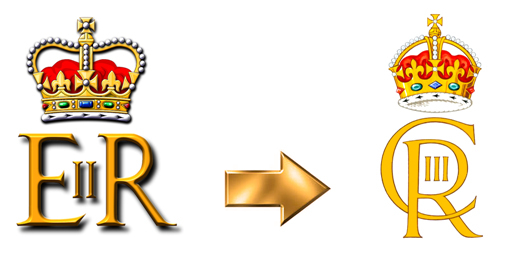 After the accession of Prince Charles to the throne of the United Kingdom, the process started to select an effigy of King Charles III in standing with the Canadian tradition of displaying the reigning British monarch on Canadian coins. You can read more about the process on the Royal Canadian Mint's web site. Click here to read their article. The design submitted by artist Steven Rosati was chosen and approved. You will note that on the right side of the obverse the text "D.G. Rex" is displayed (Rex is the Latin word for King, where Regina is the Latin word for Queen). Also, following a tradition that dates back to Charles II in the 17th century, each new monarch faces the opposite direction than their predecessor did. Because of this, the King's image faces to the left of the coins. |
|

